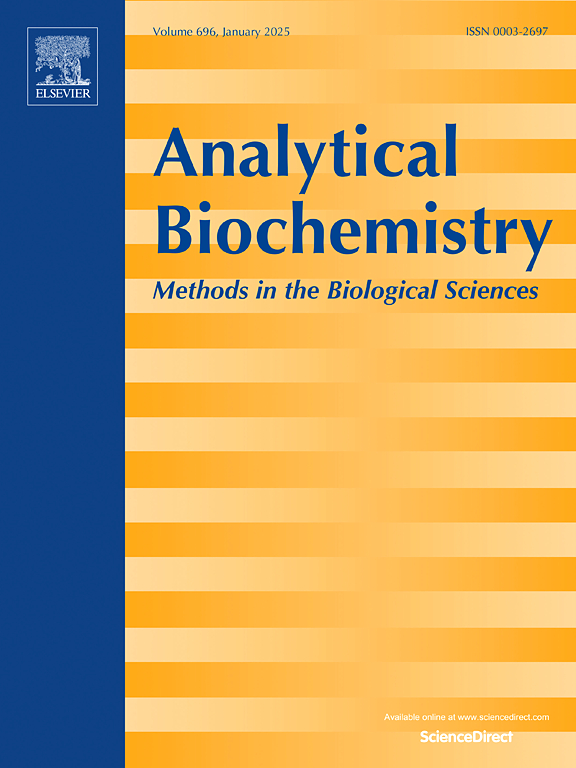Influence of experimental conditions on the adsorption of disease biomarker proteins to InP/ZnS quantum dots
IF 2.5
4区 生物学
Q2 BIOCHEMICAL RESEARCH METHODS
引用次数: 0
Abstract
The spontaneous formation of quantum dot (QD)-protein assemblies in the physiological environment exhibits challenges or benefits for nanomedicine applications. In this study, we investigated the QD-protein assemblies spontaneously formed with the greener water soluble InP/ZnS–COOH QDs and isolated disease biomarker proteins under various environmental conditions, including QDs size, solution pH, incubation time, ionic strength, different salts, as well as the lowest concentrations of the proteins that started the formation of detectable assemblies. It was shown that higher ionic strength or valence charge disrupted the assembly's formation. The basic pH 8.5 facilitated the formation to a greater extent than the pH 7.4 did. The heat shock protein 90-alpha (HSP90α) adsorbed on QDs surface more readily than cytochrome C (CytoC) and lysozyme (Lyz) in the basic environment. Among the three-sized QDs compared, the medium-sized QDs were the most effective in promoting the assemblies' formation. The detectable assemblies started at as low as 0.4 ng/mL of CytoC, 1.0 ng/mL of HSP90α, or 1.8 ng/mL of Lyz, respectively. The findings add insights into how the biomarker proteins interacted with the QDs under different environmental conditions, which promotes the understanding of QD-protein assemblies' collaborative behaviors when they facilitate bioimaging and biomedicine applications.

实验条件对InP/ZnS量子点吸附疾病标志物蛋白的影响
在生理环境中自发形成的量子点(QD)-蛋白质组装为纳米医学应用带来了挑战或好处。在本研究中,我们研究了绿色水溶性InP/ ZnS-COOH量子点和分离的疾病生物标志物蛋白在不同环境条件下自发形成的量子点蛋白组装体,包括量子点大小、溶液pH、培养时间、离子强度、不同盐,以及开始形成可检测组装体的最低蛋白质浓度。结果表明,较高的离子强度或价电荷破坏了组装体的形成。碱性pH 8.5比碱性pH 7.4更有利于形成。在碱性环境下,热休克蛋白90- α (HSP90α)比细胞色素C (CytoC)和溶菌酶(Lyz)更容易吸附在量子点表面。在三个大小的量子点中,中等大小的量子点对组合体的形成最有效。可检测的组合开始低至0.4 ng/mL的CytoC, 1.0 ng/mL的HSP90α,或1.8 ng/mL的Lyz。研究结果进一步揭示了生物标志物蛋白在不同环境条件下如何与量子点相互作用,有助于理解量子点蛋白在促进生物成像和生物医学应用时的协同行为。
本文章由计算机程序翻译,如有差异,请以英文原文为准。
求助全文
约1分钟内获得全文
求助全文
来源期刊

Analytical biochemistry
生物-分析化学
CiteScore
5.70
自引率
0.00%
发文量
283
审稿时长
44 days
期刊介绍:
The journal''s title Analytical Biochemistry: Methods in the Biological Sciences declares its broad scope: methods for the basic biological sciences that include biochemistry, molecular genetics, cell biology, proteomics, immunology, bioinformatics and wherever the frontiers of research take the field.
The emphasis is on methods from the strictly analytical to the more preparative that would include novel approaches to protein purification as well as improvements in cell and organ culture. The actual techniques are equally inclusive ranging from aptamers to zymology.
The journal has been particularly active in:
-Analytical techniques for biological molecules-
Aptamer selection and utilization-
Biosensors-
Chromatography-
Cloning, sequencing and mutagenesis-
Electrochemical methods-
Electrophoresis-
Enzyme characterization methods-
Immunological approaches-
Mass spectrometry of proteins and nucleic acids-
Metabolomics-
Nano level techniques-
Optical spectroscopy in all its forms.
The journal is reluctant to include most drug and strictly clinical studies as there are more suitable publication platforms for these types of papers.
 求助内容:
求助内容: 应助结果提醒方式:
应助结果提醒方式:


